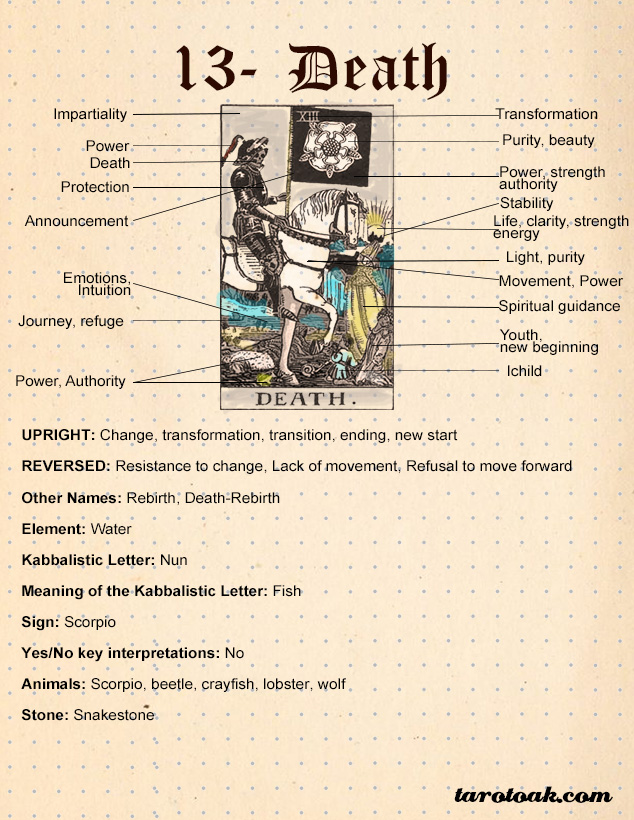The Death card, often considered one of the most misunderstood symbols within the Tarot deck, embodies profound meaning that extends far beyond its morbid nomenclature. Frequently eliciting fear or apprehension, this card unexpectedly illuminates the nuances of transformation, transition, and rebirth. It mystifies individuals, inviting them to delve deeper into its multi-layered significance.
At first glance, the imagery associated with the Death card can be unsettling. Traditionally depicted as the figure of a skeletal rider on a pale horse, the card evokes an immediate sense of finality. However, upon closer examination, the symbolism teems with rich connotations of renewal and profound change. This juxtaposition of life and death has been a topic of fascination for many, for it offers glimpses of the universal cycles that govern existence. To merely view the Death card as a harbinger of doom is to miss the deeper, underlying themes it embodies.
One common observation among Tarot enthusiasts is the tendency to equate the Death card with literal physical death. Yet, in the context of Tarot readings, the card more accurately signifies the ending of certain life phases or situations. Just as nature transitions through seasons, the Death card heralds the cessation of one chapter to pave the way for the next. This cyclical view of life reassures us of the importance of letting go and accepting endings, as they are intrinsically linked to new beginnings.
The intrinsic connection between endings and beginnings is a significant theme within various world philosophies and spiritual practices. In many ways, the Death card serves as a reminder that although endings may be painful or fraught with uncertainty, they are also necessary catalysts for growth. By embracing the concept of transformation, we can liberate ourselves from the shackles of the past. In this context, the Death card gently encourages introspection about what no longer serves us, urging a release of attachments that hinder our personal evolution.
In exploring the deeper meanings associated with the Death card, one may consider several contextual interpretations based on its position within a Tarot spread. In a reading, its placement can illuminate aspects of our lives requiring closure. A position in the past may indicate the end of a significant relationship or job. In contrast, if the card appears in the present position, it may suggest the need to confront an imminent transition, prompting the querent to reflect on how they can best navigate changing circumstances.
The Death card also resonates with the concept of existential metamorphosis. Much like the natural cycle of life, this card can symbolize rebirth or transformation. In this light, it becomes a powerful totem for those seeking spiritual evolution. For example, individuals undergoing personal crises may find solace in its presence, recognizing that through struggle comes insight and new understanding. The caterpillar’s metamorphosis into a butterfly stands as a quintessential metaphor for this type of transformation, demonstrating the beauty that can emerge from hardship.
Moreover, the presence of the Death card can serve as a potent reminder to relinquish what is outdated in our lives. Relationships, career paths, or ways of thinking may no longer align with our evolving selves. Therefore, the Death card encourages us to embrace these endings as opportunities for personal reinvention. Accepting this discomfort is an integral part of the human experience and can lead to a more authentic existence.
In individual Tarot readings, the Death card may also yield poignant insights into emotional healing. It fosters the realization that grief and loss are natural components of life’s journey. By confronting past traumas or residues of loss, we can cultivate a more profound sense of closure, thereby enabling emotional liberation. This cathartic process can, in essence, gift us with the resilience needed to face future obstacles with renewed vigor and hope.
Additionally, the Death card underscores the importance of acceptance. Accepting change is a challenging yet vital aspect of living; resistance often yields frustration and stagnation. By learning to embrace the flow of life’s vicissitudes, we invite the natural rhythms of existence into our awareness. Allowing ourselves to accept the inevitability of endings can transform our relationship with life’s unpredictable nature, fostering a deeper appreciation for the present moment.
The Death card’s allure can also be traced to its ability to provoke existential inquiries and reflections. Questions surrounding mortality, purpose, and the nature of change engage individuals in a philosophical conundrum that is as old as time itself. In grappling with these concepts, one may find themselves on a journey toward enlightenment, expanding their understanding of life’s greater tapestry.
In conclusion, the Death card in Tarot encourages a structural reappraisal of preconceived notions about death and endings. Rather than being a mere symbol of demise, it serves as an emblem of metamorphosis and renewal. By facing the profound truths encapsulated within this card, individuals may unlock pathways to personal growth, mental resilience, and enduring transformation. It beckons us to engage with the unabating cycles of life, reminding us that every ending is, in essence, a new beginning waiting to unfold.









Leave a Comment